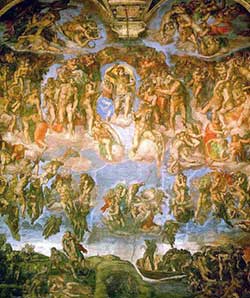 Because of the destruction of so many church buildings through the Canterbury quakes, my series on church architecture has a particular poignancy. My posts have often been on some general principle or an individual aspect. On Thursday, 1 August, I attended a lecture by Dr Denis McNamara, an architectural historian and theologian at the Liturgical Institute, Chicago. His lecture brought an overarching perspective – how do we build God’s holy places? Rather than constantly repeat “Dr Denis McNamara said”, “then he went on to talk about”, in this post I will present some points from his lecture in italics. I hope I present his ideas fairly.
Because of the destruction of so many church buildings through the Canterbury quakes, my series on church architecture has a particular poignancy. My posts have often been on some general principle or an individual aspect. On Thursday, 1 August, I attended a lecture by Dr Denis McNamara, an architectural historian and theologian at the Liturgical Institute, Chicago. His lecture brought an overarching perspective – how do we build God’s holy places? Rather than constantly repeat “Dr Denis McNamara said”, “then he went on to talk about”, in this post I will present some points from his lecture in italics. I hope I present his ideas fairly.
A good church building shares in
- eschatology – our heavenly future, expressed well in the book of Revelation
- cosmology – all of creation: nature, stars,…
- doxology – God’s glory and praise
Hans Urs von Balthasar distinguished theological aesthetics from aesthetical theology. After the eighteenth century there was an increasing loss of confidence in reason being central in religion. In religion emotion increasingly replaced reason.
This affected church architecture. We need to reclaim a church architecture which expresses an objective, pre-existent reality. Church architects are rare. They need to be agile in architectural theology, not just good architects. We are not building buildings that architects flock to look at, but few people are drawn to pray in. Who are the heroes of the architect? Augustine? What are the materials the architect tends to use? Glass, steel, concrete?
God makes from dust; to stone; transformed to precious stones, jewels. We see this from Genesis to Revelation.
Eschatology is the end of all things, the world restored and heaven and earth reunited in the person of Christ united with the Bride of the Lamb, the Mystical Body.
Anticipated eschatology is getting you used to heaven. The shadow is the Old Testament, the reality is heavenly, the image is now.
Holy Mother Church has therefore always been the friend of the fine arts and has ever sought their noble help, with the special aim that all things set apart for use in divine worship should be truly worthy, becoming, and beautiful, signs and symbols of the supernatural world, and for this purpose she has trained artists. (Sacrosanctum Concilium 122)
The East expresses this regularly as divinisation, theosis.
An illustration: If you want to run a marathon it doesn’t work to sit in your chair and wish that one day you run a marathon. You get fitter and fitter, eat well, exercise, run further and further. By the time you start running your marathon you are a marathon runner.
God does not tell us to sit in the corner and think about the bad we have done. God sends prophets and ultimately Jesus. And then we start living, start practising, that future reality now – being loving, worshipping, etc. in our liturgy and our life. We are getting used to heaven. That is anticipated eschatology. And the church building, in its art, symbolism, signs, garden images, jewels, stones – anticipates heaven.
There is bridal imagery, garden imagery, people imagery (columns represent people – often 12 columns – they have heads, pedestals {feet}, we speak of pillars of the church)…
We can think nature is unfallen, or absolutely corrupted, or it is fallen but can still, by God’s grace, be used to sacramentally reveal the beauty of our heavenly destiny. So we ask ourselves with each object we place in the church: would this appear in the heavenly Jerusalem?
The choir are members of the congregation. They are not singing to the congregation. They are not a second, small congregation.
When architects are not church architects, Dr Denis McNamara said that scholars like himself can feel like and be treated as trouble-makers on the side.
Previous posts on church architecture:
- The community – church architecture 1
- The cross – church architecture 2
- The altar – church architecture 3
- The font – church architecture 4
- The ambo/lectern – church architecture 5
- The presider’s chair/ cathedra – church architecture 6
- Church facing East – Architectural Design Guidelines 1
- Why churches face East – Architectural Design Guidelines 2
- The altar in architectural design – Architectural Design Guidelines 3
- The baptism font in architectural design – Architectural Design Guidelines 4
- planning inside out
- worship space
- art – spirituality – architecture
- Dr Denis McNamara videos on architecture


